Tuning nanoparticle dispersion in a polymer matrix
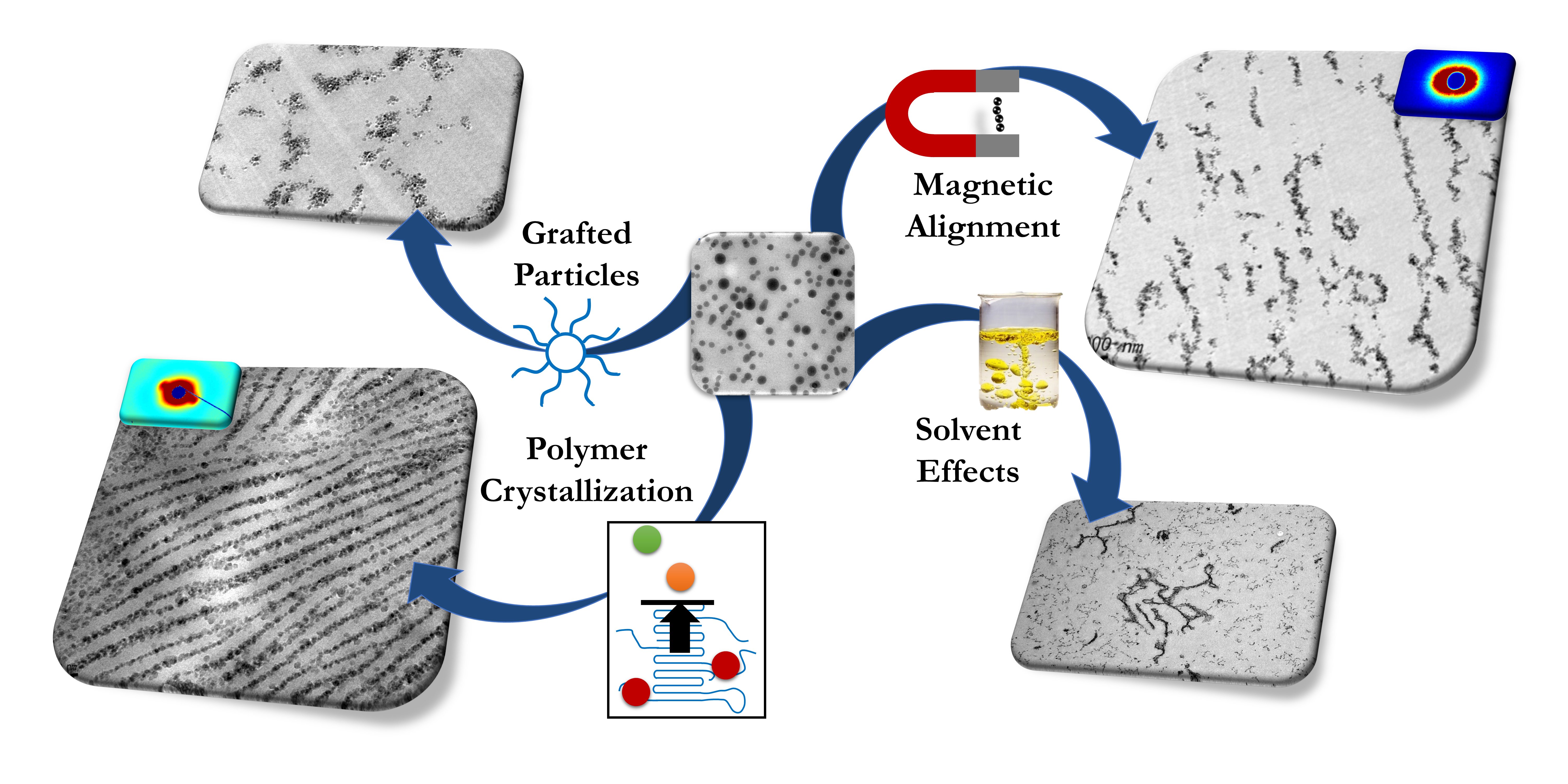
There has been considerable interest in manipulating the spatial distribution of nanoparticles (NPs) in a polymer matrix to create composite materials with novel or significantly improved properties. Previously, we have shown that, depending on the grafting density and chain length, the NPs structures in an amorphous polymeric host can be tuned from well dispersed, strings, sheets to spherical aggregates. More importantly, it had also been found that optimization of different material properties might require different nanoparticles dispersion states. To generalize these ideas, current efforts are mainly focused on tuning the NPs dispersion states in a semi-crystalline matrix by controlling the rate of polymer crystallization. In particular, the interplay between matrix crystallization and NPs re-organization is thoroughly examined. Most recent results clearly stress that crystal growth kinetics represents an underappreciated handle to tailor the NP spatial dispersion and hence the properties of this class of commercially relevant polymer nanocomposites.
Abdullah Al Torbaq; Alejandro Krauskopf; Sabin Adhikari; Nico Mendez
Controlling transport properties of polymer composites
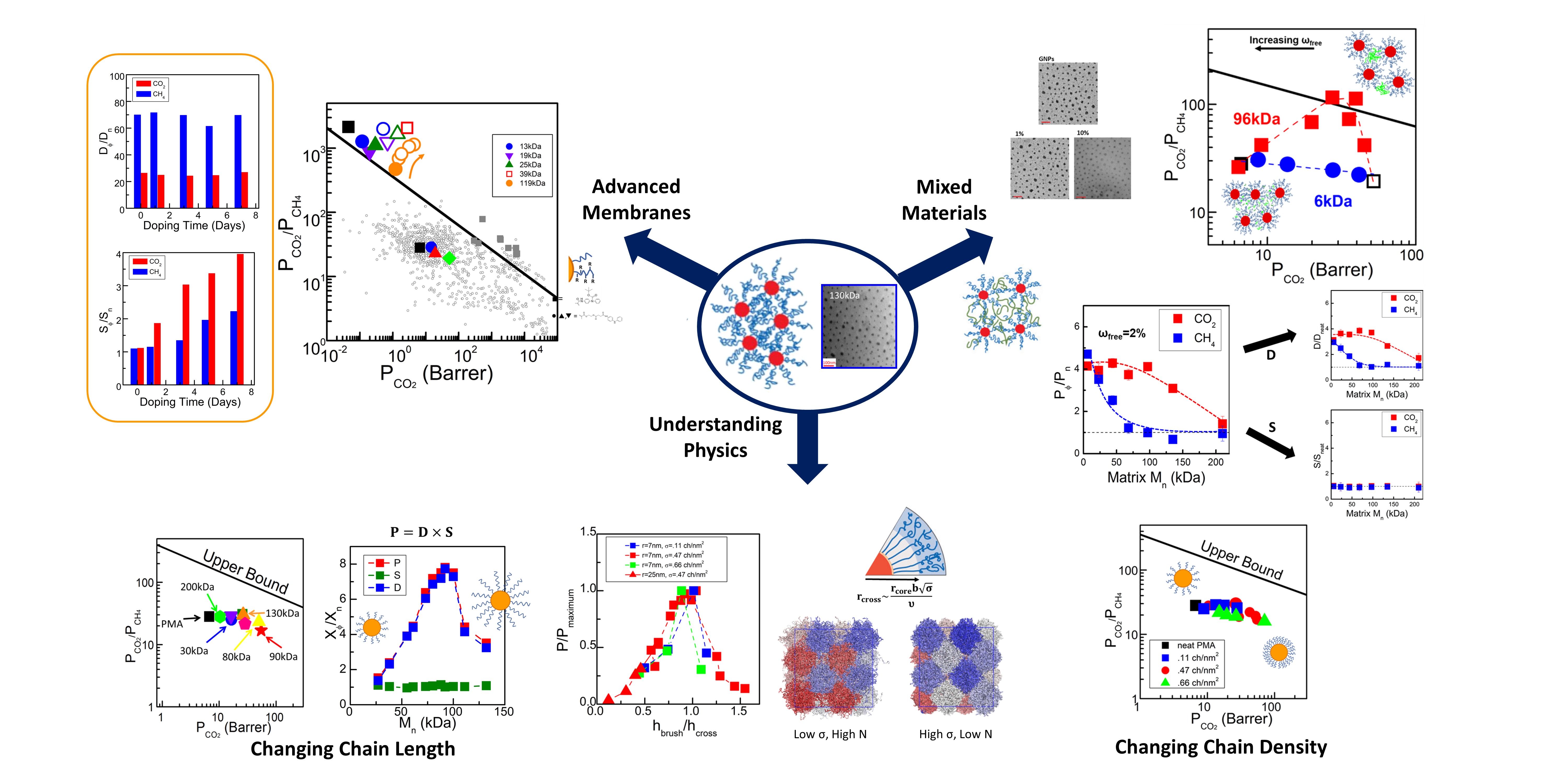
Optimal spatial nanofiller dispersion can yield significantly improved behavior, such as enhanced gas permeation. Both experiment and theory have demonstrated that covalently grafting polymer chains onto the nanoparticles improves their miscibility in solvents and in polymer matrices, providing a synthetic route for control of structure in nanoparticle/polymer systems. With this newfound morphological control, we create membranes from a variety of polymer-grafted nanoparticles with superior performance compared to their non-grafted counterparts. We strive to understand the underlying physics of the structure-property relationship that arise from these extraordinary results, which find applications in membrane gas separation and gas barrier materials.
Sophia Chan; Robert Tannenbaum
Compatibilization of immiscible polymer blends using polymer-grafted nanoparticles
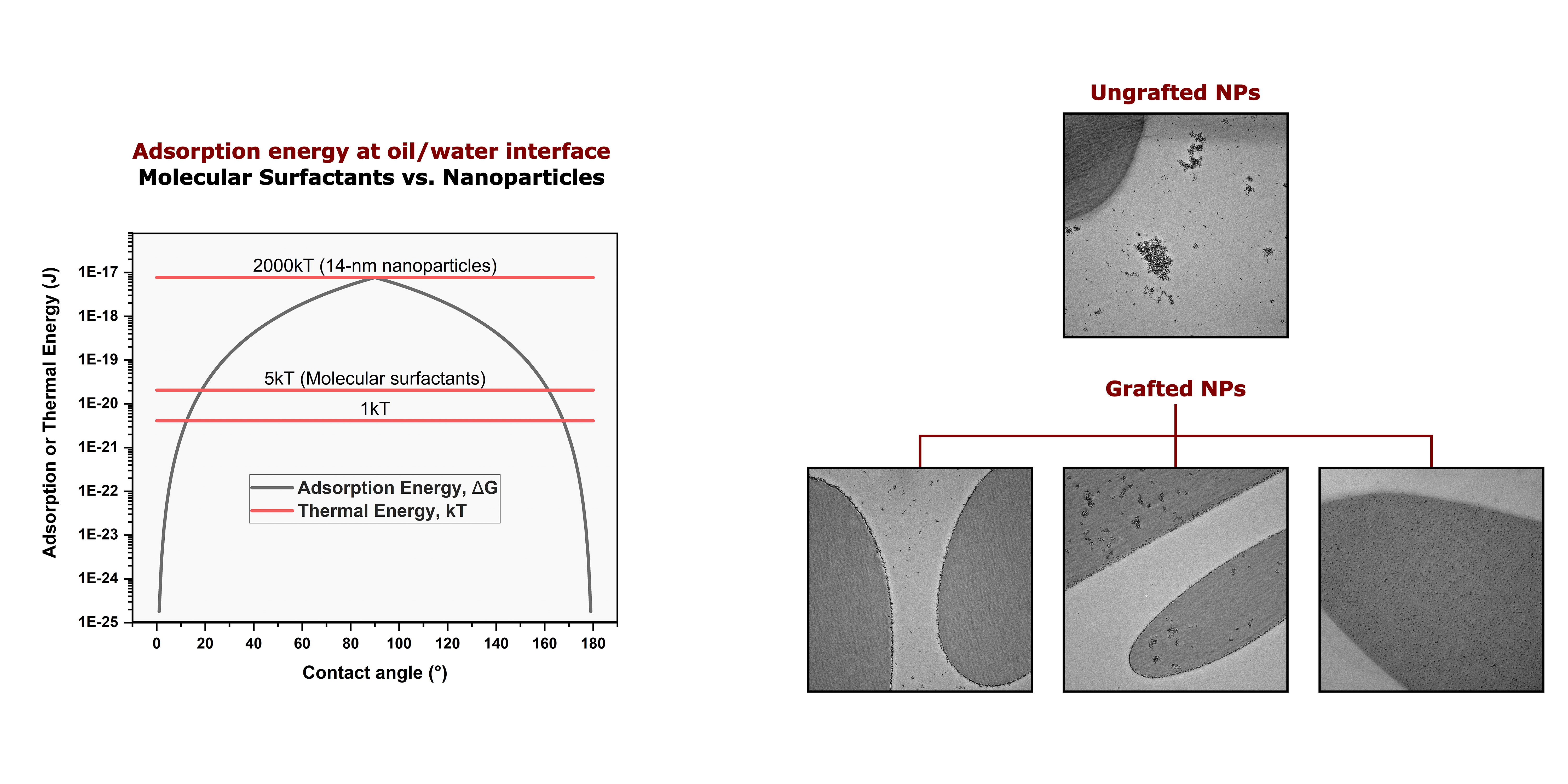
Polymer blending is a convenient route for combining the desirable properties of different polymers into a single material. Unfortunately, most polymer pairs are immiscible due to their unfavorable interaction and are thus characterized by unstable morphologies and poor mechanical properties. Traditionally, such immiscible systems have been “compatibilized” by the addition or, more commonly, the in-situ formation of block copolymers; the polymeric analogs of molecular surfactants. Recently, nanoparticles (NPs) have been proposed as an alternative due to their high surface area and strong adsorption at interfaces, but they are known to be difficult to disperse in polymeric hosts. Recent work by our group has shown that NPs lightly grafted with polymer chains exhibit a range of dispersion states (well-dispersed, sheets, strings, …) and behave akin to surfactants in polymer matrices. This makes grafting a potential tool for directing NP self-assembly at polymer-polymer interfaces.
Husam Alkhodairi
Modeling the entanglement distribution in polymer-grafted nanoparticle systems
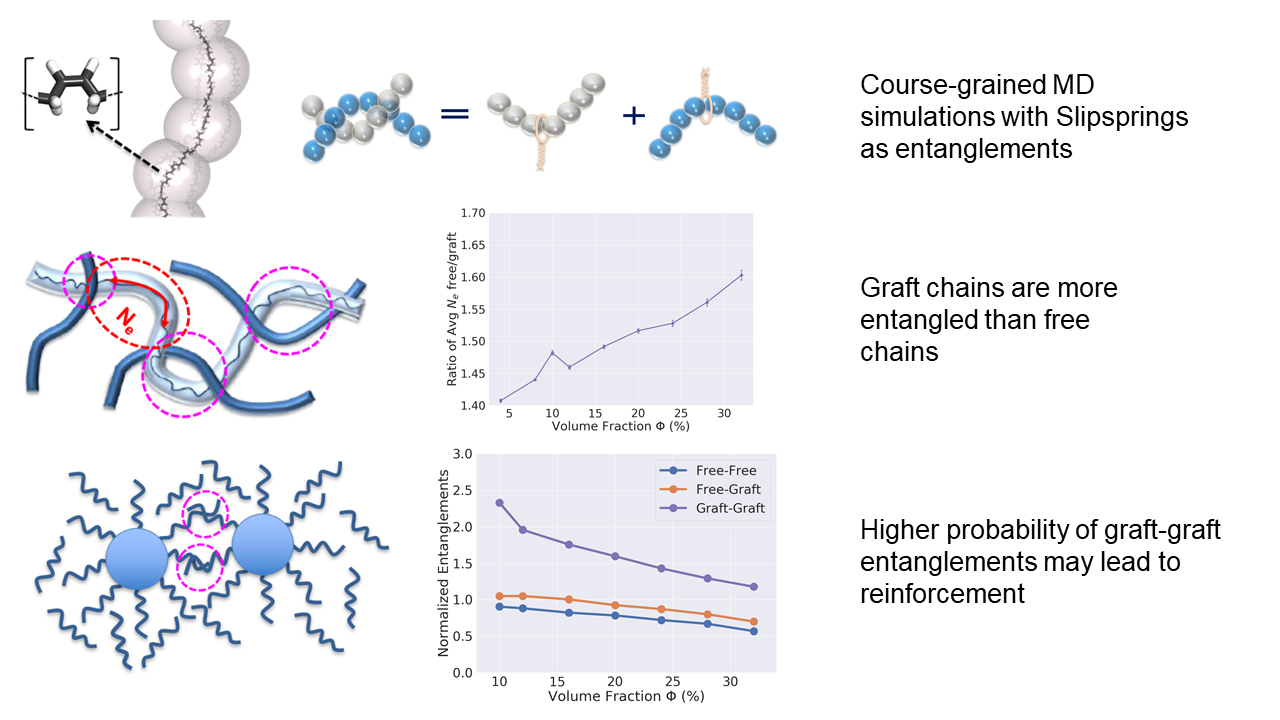
Polymer nanocomposites have become increasingly useful materials due in part to their ability to provide improved strength and mechanical reinforcement over pure polymer systems. Difficulty controlling nanoparticle dispersion in these nanocomposites led to the use of grafted nanoparticles, or nanoparticles with polymer chains tethered directly to their surface, embedded in matrices of free polymer chains. We believe the nature of the improved mechanical properties in grafted systems is the result of graft chains on different filler particles forming an entanglement network. A computational modeling technique was developed that utilizes slipsprings to model the mobility constraints that physical entanglements impose on individual polymer chains. Focusing on the distribution of entanglements, we found that graft chains appear to be more highly entangled than free chains, irrespective of filler particle loading. The amount of inter-particle graft interactions is also always higher than we would expect if the entanglement pairs were randomly distributed based solely on their probability of occurrence.
Robert Tannenbaum
Dynamic properties of polymer grafted nanoparticles
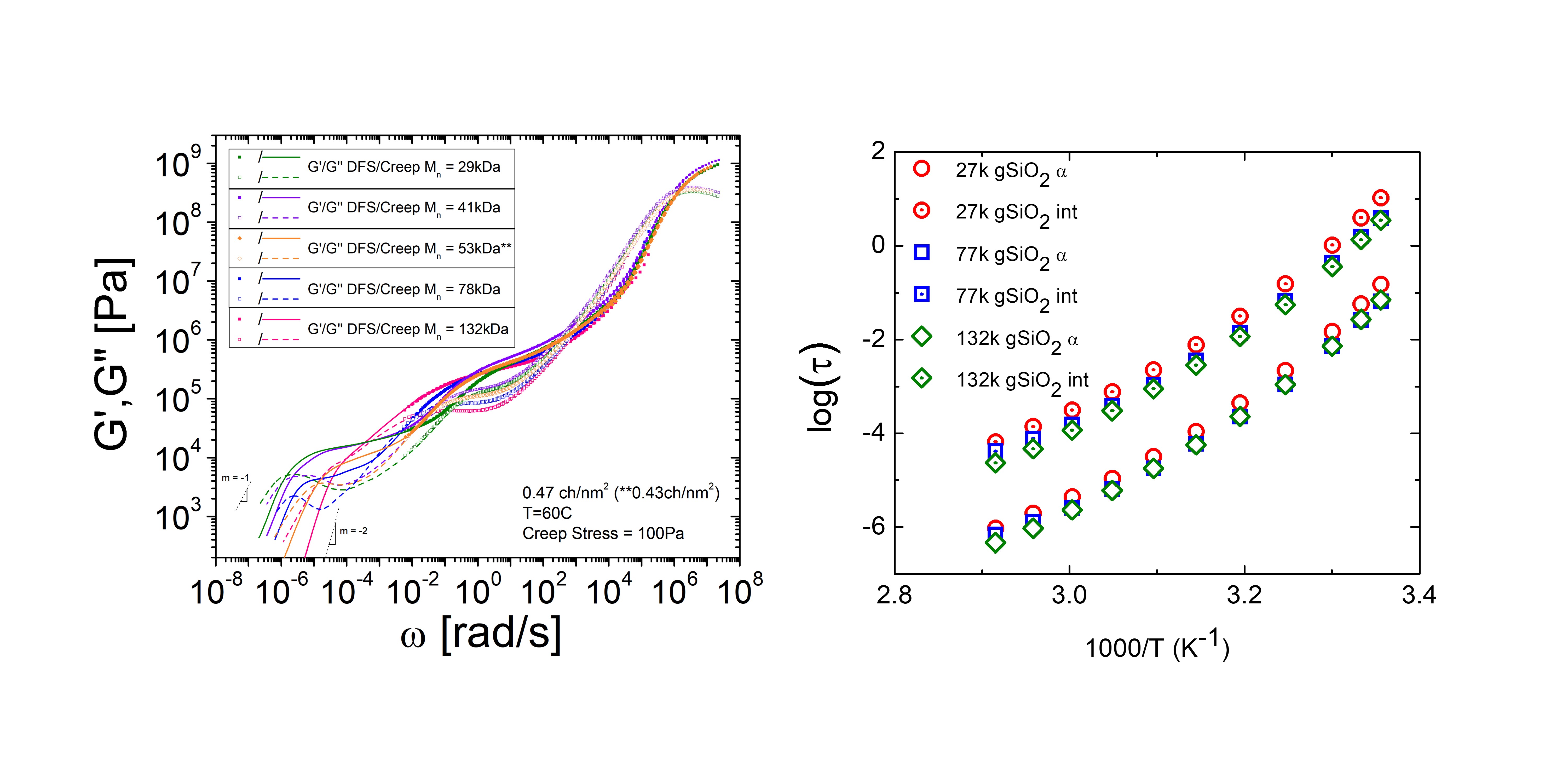
The properties of polymer nanocomposites are intrinsically linked to the structure and dynamics of the system, which in turn are linked to each other. Our research focuses on understanding the structure-dynamics-property nexus in novel matrix-free polymer composites as well as filled elastomers with the view of developing a holistic understanding of the key features required to create materials with controllable properties.
Some of the current research projects in the group are:
a) Microscale polymer dynamics in matrix free polymer composites to understand the link between polymer dynamics and gas transport
b) Rheology and dynamic mechanical testing of filled elastomers to probe the impact of various structures on the mechanical properties, in the melt and the crosslinked forms
c) Constrained nanoparticle motion in matrix-free polymer composites to probe their unique jamming and aging behavior
d) Extracting polymer properties through dilute Tracer diffusion in polymer composites.
e) Dynamical aging in polymer composites induced through processing
f) Tracking the temperature dependence of segmental (α) and local (β) relaxations in matrix-free polymer grafted nanoparticles using broadband dielectric spectroscopy (BDS)
Deboleena Dhara, Marshall Tekell
Coarse-grained molecular dynamics simulation of polymer electrolytes
We are currently developing methods to coarse-grain polymer electrolytes for applications in Li-ion batteries. In order to study Li+ diffusion in nanostructured solid polymer electrolytes, models that (1) capture local electrostatic interactions between Li+ and the polymer chain (r ~ 2-5 Å) and (2) nanocomposite structural features on the polymer chain length scale ( 𝑅𝑔 ~101−2 Å) are required. In this work, PEO is modeled as a Kremer-Grest bead-spring polymer at the Kuhn scale with ideal, Stockmayer dipoles embedded in each bead.
Marshall Tekell
Dielectric properties of polymer nanocomposites
Dielectric relaxation spectroscopy (DRS) can be used to measure molecular dynamics in a polymer nanocomposite. An oscillating electric field induces collective rearrangements of molecular dipoles in a frequency range that depends on the temperature of the nanocomposite. We are studying the relationship between the dynamics observed in DRS and important bulk transport properties, such as gas diffusivity and ionic conductivity.
Marshall Tekell
Machine learning as applied to nanoparticles and polymers
We are currently looking at convolutional neural networks (CNNs) as a way to enable quantitative studies on DNA origami formations (collaboration with Dr. Gang's group). Simple image processing techniques fail to recognize boundaries of transparent objects like the lattices encountered in the microscope imagery provided, as well as cases of overlap and focal differences. Analysis of system dynamics would compound these errors over each frame in a video, suggesting an adaptable model is required for such a study. Our current goal is to balance the network's simplicity and performance, ultimately leading to a focus on the kinetics of lattice formation.
Tejus Shastry